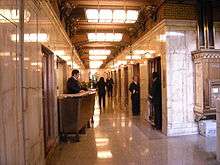Elevator operator

An elevator operator (in British English, usually lift attendant) is a person specifically employed to operate a manually operated elevator.[1]
Description
Manual elevators were often controlled by a large lever which would cause the elevator to stop or run and sometimes also regulate speed, and typically required some skill or sense of timing to be able to consistently stop the elevator level with the doorway of a floor. Besides their training in operation and safety, later, department stores extended the roles of operators as combination greeters and tour guides, announcing product departments, floor-by-floor, and occasionally mentioning special price offers.
With the advent of user-operated elevators such as those utilizing push buttons to select the desired floor, few elevator operators remain. A few older buildings still maintain working manually operated elevators and thus elevator operators may be employed to run them. The Young–Quinlan Building in downtown Minneapolis, Minnesota and City Hall in Buffalo, New York are two of the few in the United States to employ elevator operators. The Stockholm Concert Hall, in Sweden, employs an elevator operator by necessity since there is an entrance to the elevator directly from street level, requiring an employee to be positioned in the elevator to inspect tickets.
In more modern buildings, elevator operators are still occasionally encountered. For example, they are commonly seen in Japanese department stores such as Sogo and Mitsukoshi in Japan and Taiwan, as well as high speed elevators in skyscrapers, as seen in Taipei 101, and at the Lincoln Center for the Performing Arts. Some monuments, such as the Space Needle in Seattle and the Eiffel Tower in Paris employ elevator operators to operate specialized or high-speed elevators, discuss the monument (or the elevator technology) and to help direct crowd traffic.
There are a few elevator operators working in the New York City Subway system. They are located at four stations: 168th Street, 181st Street, 190th Street, and 191st Street subway stations in Washington Heights, upper Manhattan; the elevators were made automated during the 1970s, but the operators were retained, albeit being reduced in quantity in 2003. The elevator operators in the New York City Subway system serve as crowd controllers, and elevator operators usually had other jobs in the Metropolitan Transportation Authority prior to being assigned to that job.[2]
Theme parks and amusement parks often have observation towers, which employ elevator operators. An example is the Sky Tower at Six Flags Magic Mountain in Santa Clarita, California. While these rides may have modern or button-operated elevators that a patron is capable of using, these rides often employ ride operators for safety and crowd control purposes. Because many jurisdictions have stringent injury liability laws for amusement park operators and the fact that vandalism can be a big problem, some parks do not allow patrons to ride these rides without an employee present. Additionally, if there is a museum at the top of such a ride, the operator will usually give an introduction to the purpose and contents of the museum and other promotional messages about the park.
References
- ↑ http://www.npr.org/templates/story/story.php?storyId=124251060
- ↑ The Subway’s Elevator Operators, a Reassuring Amenity of Another Era. By MICHAEL M. GRYNBAUM. Published: April 28, 2011. The New York Times.